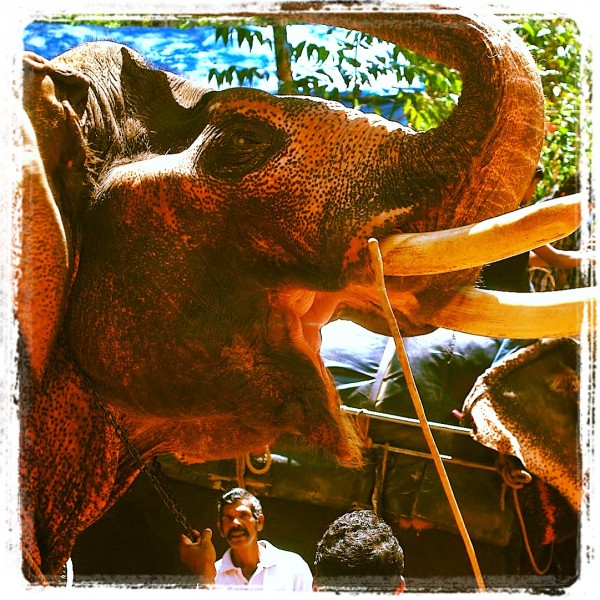
Photo by ST. JOHN BARNED-SMITH
Dear Phawker,
It’s been a while. After weeks of bus travel, sleeping in dingy guesthouses, avoiding tenacious touts, and gulping down Indian food ranging from the just-mildly spicy to the infernal, I had arrived at Cape Comorin, the southern tip of the country. Today, I wiggled my toes in the sand and looked out across three oceans. The sand was coarser than I’d expected. And the empty fishing village I’d been imagining seemed more like India’s version of the Jersey shore. The waves were blue and clear and the white caps were pure and foaming but crud littered the beach and cheap trinket sellers, the boardwalk.
Anyways, it’s been a long trip. I’d wandered in the footsteps of rajs in Delhi, of the great explorers of the 1500s in Goa and Kerala, and the great southern Hindu kings of Vijayanagar in Hampi, and for a second I felt a bit like them. Which is absurd, of course. From Delhi, where I spent most of the week melting from 100+ heat, I traveled south to Mumbai, where a cab driver immediately ripped me off.
I wandered through Mumbai in a little bit of a daze. (Congestion in India is nothing – NOTHING – like congestion in the US. A clusterfuck of epic scale, it’s like 400 times a million minus the swords and sandals.) I visited the Elephanta Caves, huge and ancient. Twelve hundreds of years ago, Hindu devotees and others visited these islands just off Mumbai’s coast and carved massive temples into the caves that riddle the islands’ hills. The sun glinted off the lead gray water, and the air felt like a thick wet sock.
But the statues were thrilling. Even after all this time, they were in remarkable condition, scenes from the Ramayana (I think) and the enigmatic figures loomed out of the rock wall in martial poses, like grim sentinels. In one cave I came across a massive figure with three faces. It towered above me in the half light, both majestic and ominous.
I decided to travel to Hampi next. I’d heard a lot about this village, which holds the ruined capital of the Vijayanagar Empire. I spent a couple of days scampering through the pristine ruins of a city that was once the second biggest on Earth. The area around the temples is littered with piles of granite boulders lying in tangled heaps, which looks like nothing else on this Earth.
Leaving Hampi, I had a new challenge to worry about – monsoon. India’s monsoon usually starts in late May, and can carry all the way through August. By all accounts, it is ferocious. I knew this, but I desperately wanted to see the coasts of Goa and Kerala, which are supposed to be some of India’s most beautiful areas. So I gambled. I took a bus to the western coast of India, to Goa. The state is especially famous because this is where the Portuguese first showed up after rounding the tip of Africa. They were the imperial heavies, before England showed up and did its thing. During their time here, the Portuguese had enough time to build the largest cathedral in India – and Asia – and a scattering of other churches, chapels, basilicas, and forts throughout the region.
I tracked across India’s western coast, praying for clear skies, and for the most part it worked out. There were a few days where the skies opened with a sort of cleansing fury, but in general, the weather held. (Thank god for el niño, I guess). Even when I got to Kerala (where the rain should have been a liquid wall), the skies stayed (mostly) dry. I wandered around Fort Cochin, and then made my way up into Kerala’s share of the “Western Ghats,” huge ridges filled with nausea-inducing hairpin turns and cool breezes. I also found some elephants.
And then, a trip to Trivandrum, an inauspicious little town where the taxi drivers tried to charge me more than three times the going rate. I stayed there for a night before I acknowledged that its only saving grace was probably the zoo, which had amazing exhibits, and enough lions, tigers, jaguars, and leopards to satisfy the most tormented of furries. And there was a king cobra. They get up to 13 feet long, apparently. The one I saw had a body as thick around as a 2-liter bottle of soda – it looked particularly evil. (I know there are people in this world who like snakes. I’m not one of them, and that’s despite two years back in high school working in the reptile house at my local zoo.)
Now, I’m in the formerly-French port of Puducherri, heading north along the eastern coast. It’s a mostly quaint little town but for the main strip which looks like a little like the avenues off of Times Square. There’s good coffee (Thank God for the French!), croissants, and all the streets have French names. I head north tomorrow, to the coastal city of Visakapatnam, an Indian beach which from what I’ve read, sounds suspiciously like the Jersey Shore. No matter. Surfing – and cotton candy – awaits!
love,
St. John Barned-Smith
South Asia Correspondent
